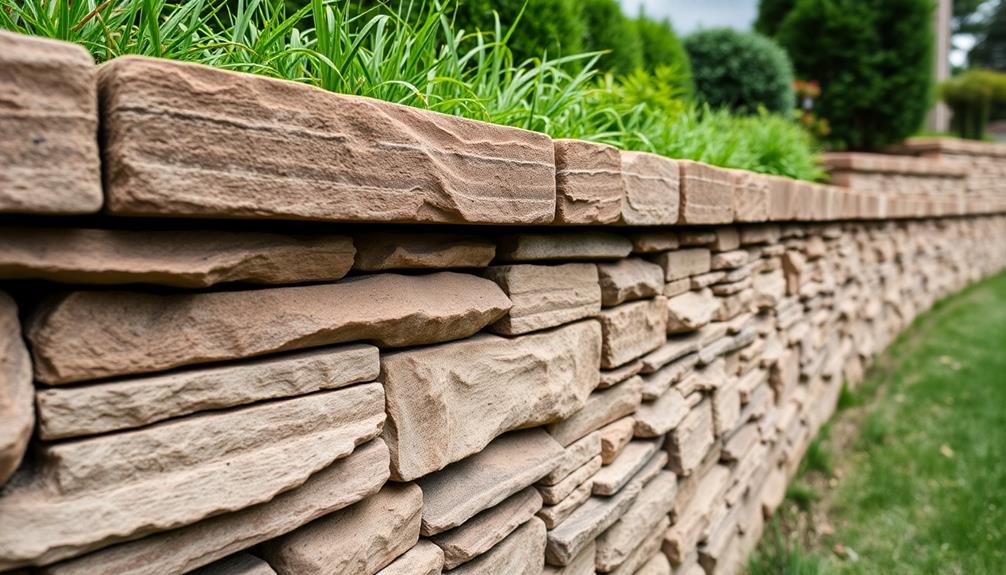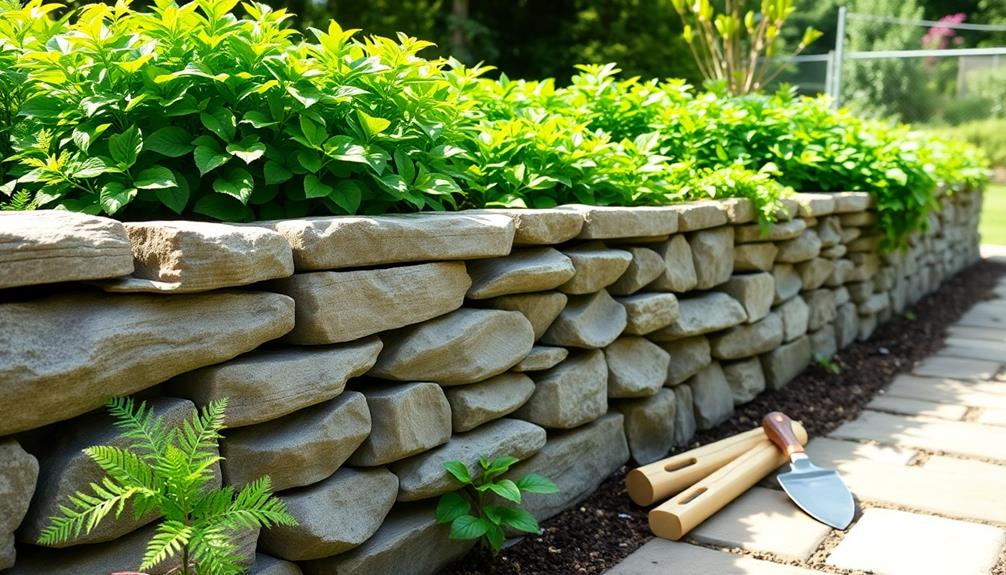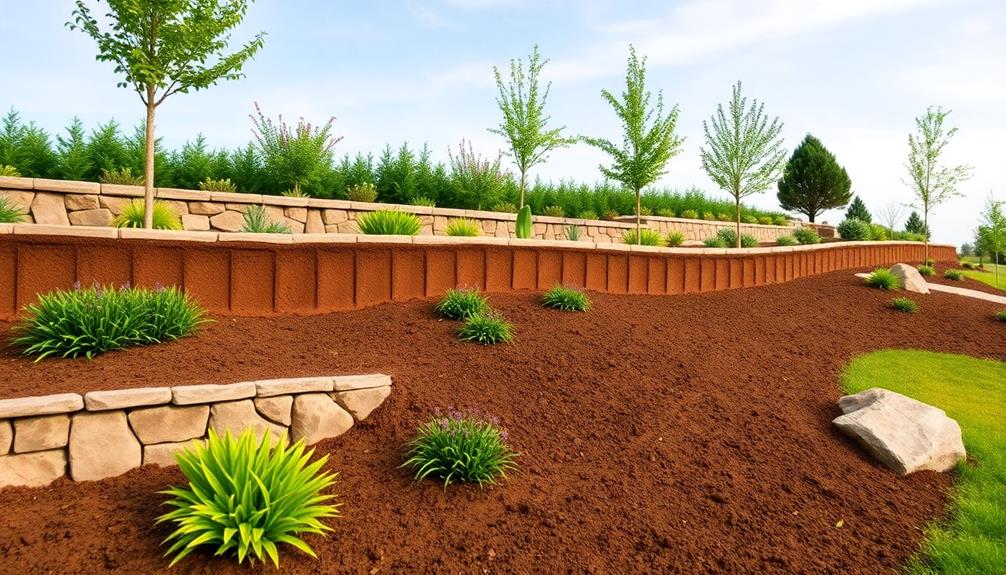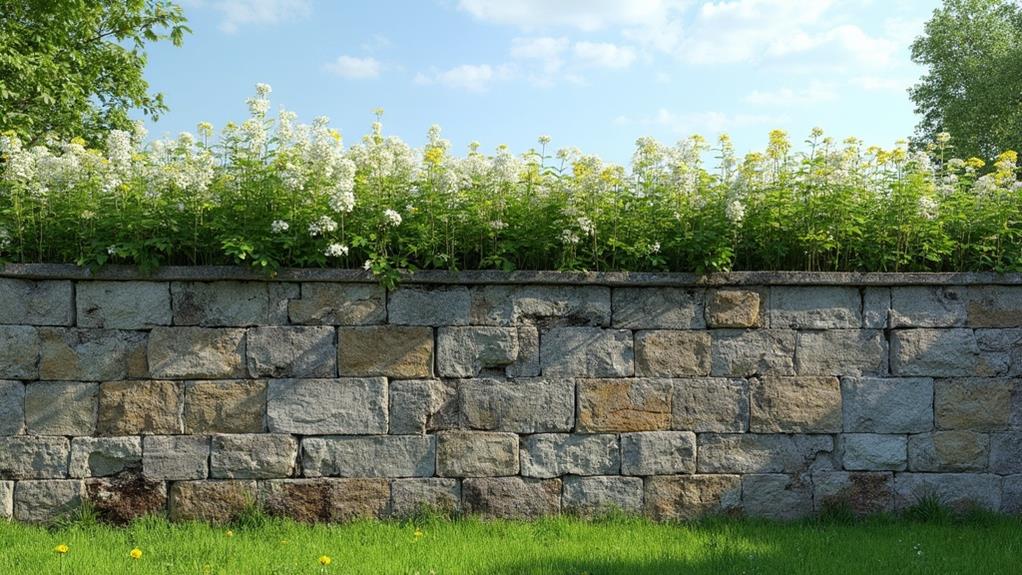Seeking professional assistance for retaining wall repairs guarantees the structure's stability by addressing both visible and hidden issues through expert inspections. Specialists employ advanced techniques and materials that comply with safety regulations, thereby preventing potential structural failures that could result in erosion or flooding. This proactive approach not only saves time and reduces future repair costs but also enhances safety by minimizing risks of accidents. Additionally, professionals enhance the wall's aesthetic appeal, integrating it seamlessly with its surroundings and boosting property value. For those interested in ongoing maintenance and warranty services, further insights await exploration into this all-encompassing offering.
Table of Contents
ToggleWalls Contractor Highlights
- Professional repairs ensure the retaining wall's stability and long-term functionality by meeting safety and legal requirements.
- Experts conduct thorough inspections to address structural issues, reducing the risk of erosion or collapse.
- Professional help saves time and prevents future costly emergency repairs with industry knowledge and best practices.
- Professional repair services enhance the wall's aesthetics, integrating it with the landscape and boosting property value.
- Comprehensive maintenance and warranty services offer ongoing support and assurance of the wall's performance.
Definition of Retaining Walls

Retaining walls serve the primary function of holding back soil and preventing erosion, often employed in landscaping and construction to support vertical or near-vertical grade changes. In the Twin Cities area, a range of materials such as limestone, boulders, and granite are utilized for building these walls.
Typically constructed from materials such as concrete, stone, or timber, these walls require careful consideration of structural design elements, including stability, drainage, and load-bearing capabilities. Understanding the purpose and versatility of retaining walls not only aids in appreciating their aesthetic and functional value but also underscores the importance of seeking professional assistance for repair and maintenance to guarantee their long-term effectiveness.
Purpose and Functionality
Engineered to withstand the forces of soil pressure, retaining walls serve as essential structures in a variety of landscapes, preventing soil erosion and managing slopes effectively. These walls provide communities and businesses with the crucial function of ensuring stability in areas where terrain would otherwise challenge construction and inhabitance.
Retaining walls are intricately designed to maintain soil at distinct levels on each side, allowing for the utilization of properties while enhancing safety and aesthetics. By doing so, they become intrinsic to creating harmonious environments, fostering a sense of unity between man-made structures and nature.
To better comprehend their purpose and functionality, consider these key aspects:
- Erosion Control: Retaining walls are pivotal in preventing the movement of soil downhill due to rain and natural gravitational forces, safeguarding the landscape and minimizing land degradation.
- Slope Management: Through the stabilization of hillsides, these walls enable the construction of level areas that can be used for agriculture, recreation, or building development.
- Aesthetic Enhancement: Beyond their practical purposes, retaining walls add architectural interest to properties, potentially involving intricate designs that blend seamlessly with the environment.
- Water Management: Strategically designed retaining walls help in directing water flow and preventing flooding, accommodating efficient drainage routes that protect adjoining properties.
Mastering these aspects allows communities to thrive together, reinforcing bonds through shared infrastructure challenges.
Common Materials Used
While understanding the purpose and functionality is fundamental, another essential aspect of retaining walls lies in the materials used for their construction. Retaining walls serve as both practical solutions in landscape management and aesthetic enhancements to exterior spaces, hence selecting appropriate materials is indispensable.
Commonly, these structures are crafted from concrete, brick, stone, or wood. Concrete offers durability and a variety of finishes, making it versatile for most landscapes. Additionally, concrete blocks can be manufactured with interlocking features, enhancing stability with fewer materials.
Brick, on the other hand, is often chosen for its classic appearance and durability, complementing many residential designs seamlessly. Stone, renowned for its natural beauty and strength, can produce retaining walls that are both rustic and robust, blending organically with garden settings. Wood provides a warmer, more traditional alternative, suitable for smaller projects or temporary installations.
Each material brings distinct advantages and is selected based on factors such as cost, local climate, and intended design. Understanding these nuances helps homeowners and professionals make informed decisions, ensuring that their retaining walls are not only functional but also a harmonious component of the landscape.
Structural Design Basics
A retaining wall acts as an essential engineering solution that holds back soil and prevents erosion, particularly in landscapes with varying elevations. Its structural significance cannot be overstated, as a well-designed retaining wall guarantees the stability and usability of uneven terrain.
These walls are indispensable in both residential and commercial settings, providing peace of mind and security for property owners and communities. Understanding the basic principles of retaining wall design is critical for ensuring optimal performance and longevity.
The fundamental components of structural design for retaining walls include factors such as wall height, material choice, drainage solutions, and environmental considerations.
- Wall Height: Determining the appropriate height of the retaining wall is pivotal; this influences stability and dictates the wall's engineering requirements.
- Material Selection: The choice of materials—whether concrete, stone, or timber—impacts the wall's durability and aesthetic integration with its surroundings.
- Drainage Systems: Proper drainage design is crucial to manage water pressure and prevent erosion, thereby enhancing the wall's integrity.
- Environmental Assessment: Understanding soil characteristics and environmental conditions is paramount to ensure that the wall effectively meets its intended purpose.
Professionals in this field have the expertise to navigate the complexities involved, guaranteeing that each retaining wall serves as a steadfast barrier against the forces of nature.
Benefits

Engaging professional services for retaining wall repairs offers a multitude of advantages, prominently safeguarding the structural integrity essential for safety and longevity. By hiring experts who have the expertise and experience to manage the repair process, property owners can guarantee that appropriate engineering and design considerations are made, especially for complex wall types.
Property owners not only save significant time and effort but also benefit from access to specialized tools that are indispensable for effective and precise repairs. Additionally, professional intervention helps prevent future damages, thereby protecting the investment and reducing the likelihood of costly emergency fixes down the line.
Ensures Structural Integrity
Securing the structural integrity of a retaining wall is paramount to its functionality and longevity. Engaging professional help guarantees that these structures are not only stable but also designed to withstand environmental pressures and natural wear over time.
Professional contractors possess the expertise, tools, and materials to assess, repair, and reinforce retaining walls effectively. By doing so, they prevent potential failures that could lead to erosion, flooding, or even structural collapse, thus safeguarding property and minimizing future repair costs.
- Thorough Evaluation: Professionals conduct meticulous inspections, identifying both overt and subtle issues compromising the wall's integrity.
- Advanced Techniques: They deploy state-of-the-art techniques and materials which reinforce stability, addressing specific structural challenges that amateur repairs might overlook.
- Compliance and Standards: Adhering to the latest engineering standards and local regulations, professionals make certain that repairs meet all safety and legal requirements.
- Expertise in Complex Situations: Experienced contractors are adept at managing geological and environmental factors, which can heavily impact the wall's performance.
Utilizing professional services for retaining wall repairs cultivates a sense of confidence and assurance, reinforcing not just the wall's structure, but peace of mind for the homeowner as well.
Saves Time and Effort
Building on the importance of structural integrity, seeking professional help for retaining wall repairs also considerably saves time and effort for property owners. Engaging with knowledgeable professionals streamlines the repair process, offering efficiency that can hardly be matched through personal endeavors.
Specialized teams are adept at handling complex structural challenges swiftly and systematically, freeing property owners from intricate repair tasks that require substantial technical proficiency. By entrusting these experts with the work, property owners can redirect their focus towards other critical life tasks or business operations, fostering a sense of community cohesion and the reassurance of knowing their property is in expert hands.
The time saved is significant; what could take an inexperienced individual weeks to accomplish can often be reduced to mere days by seasoned practitioners. Furthermore, the effort associated with the physical labor and mental strain involved in planning, analyzing, and executing wall repairs is greatly minimized.
Professional repair services bring an intimate understanding of all facets involved, from evaluating the extent of damage to implementing effective solutions efficiently. This guarantees not only the timely completion of necessary repairs but also peace of mind, aligning with the shared aspiration of maintaining our properties in harmony with our community standards.
Access to Expert Tools
Access to expert tools stands as a fundamental advantage when opting for professional retaining wall repair services. Employing specialized equipment is not merely about sophistication but about precision and efficiency, offering tangible benefits to homeowners and property managers who prioritize reliable outcomes. This access guarantees that repairs are not just completed but optimized for long-term stability and function.
The intricate nature of retaining wall systems necessitates specific tools designed to address a range of structural challenges.
- Precision Instruments: Professionals use advanced laser levels and compaction equipment that facilitate accurate alignment and stability, critical for the wall's integrity.
- Specialized Machinery: Earth-moving equipment and hydraulic devices capable of handling heavy materials safeguard robust construction and modification, tailored to each unique site.
- Durability-Enhancing Gear: Cutting-edge sealing and anchoring technologies enhance the longevity of repairs, reducing the risk of immediate rework, contributing to peace of mind for property owners.
- Safety Resources: With equipment specifically engineered to manage heavy wall components safely, professionals mitigate risks effectively, underscoring their commitment to protecting both workers and residents.
These tools underscore the thorough skill set professionals bring to each project, allowing clients to feel confident and secure in their decision to engage expert services.
Prevents Future Damages
Preventing future damages is a pivotal benefit of engaging professional services for retaining wall repairs. Professionals possess the specialized knowledge necessary to accurately diagnose underlying issues that might go unnoticed by an untrained eye. They hold a keen understanding of stress distributions, soil dynamics, and hydrostatic pressures, which are indispensable factors in maintaining the structural integrity of a retaining wall.
By addressing these aspects meticulously, professionals guarantee that the wall is not only repaired effectively but is also fortified to withstand potential detrimental forces that could cause future damage. Additionally, professional repair services offer access to advanced techniques and durable materials that may not be available to the average homeowner. This equips them to implement solutions that are both robust and long-lasting.
Their capability to foresee potential weaknesses and reinforce them reinforces your property's security, preserving its aesthetic and functional qualities for years to come. Importantly, this preventive approach is cost-effective in the long term, as it reduces the necessity for recurrent repairs, thereby offering peace of mind to property owners who are part of a community that values safety and durability. Employing professionals, in this manner, nurtures a shared sense of trust and reliability.
Soil Erosion Prevention Tips

Addressing soil erosion is a multidimensional effort that involves strategically implementing ground cover plants, installing effective drainage systems, and adhering to regular maintenance practices to guarantee the longevity and stability of retaining walls. Utilizing these methods not only minimizes the risk of erosion but also contributes to the durability and aesthetic appeal of landscape projects. The table below outlines key strategies involving these techniques for effective erosion control:
| Strategy | Benefits | Implementation Tips |
|---|---|---|
| Ground Cover Plants | Enhances soil stability | Choose native species for best results |
| Drainage Systems | Prevents water accumulation | Ensure proper grading and outlets |
| Regular Maintenance | Prolongs wall integrity | Inspect and repair any damage promptly |
Utilize Ground Cover Plants
Incorporating ground cover plants is an effective strategy for preventing soil erosion around retaining walls. These plants provide stability to the soil by covering the surface and reducing the impact of rainfall. Accordingly, their root systems help lock the soil in place, minimizing erosion risks while promoting a sense of cohesion and connection with nature.
Below are reasons why utilizing ground cover plants is a sound choice:
- Erosion Control: Ground cover plants, such as creeping thyme or vinca minor, create a natural barrier, effectively reducing the speed of water runoff and maintaining soil integrity.
- Aesthetic Appeal: These plants can enhance landscaping by introducing a lush green carpet that complements the architectural structure of the wall, fostering an inviting environment.
- Low Maintenance: Once established, ground cover plants typically require minimal upkeep, offering sustainable foliage with little intervention, consequently saving both time and resources.
- Biodiversity Support: Ground covers can provide habitats for beneficial insects and small wildlife, nurturing a thriving ecosystem that enriches the surroundings.
Install Drainage Systems
Proper drainage systems are critical for effective soil erosion prevention around retaining walls. When installed properly, they confirm the stability and longevity of the retaining walls, thereby securing your landscape's structural integrity. A lack of a well-thought-out drainage solution often results in water accumulation, which might lead to soil saturation and increased lateral forces on the wall, ultimately compromising its stability.
To address this, incorporating efficient drainage systems such as weep holes, French drains, or perforated pipes is advisable. These systems are designed to effectively redirect water away from the base of the retaining walls, mitigating the risk of erosion and wall displacement.
Hiring a professional to evaluate and install drainage systems guarantees a tailored approach suited for specific landscape requirements, factoring in elements like soil type, climate, and topography. These experts will seamlessly integrate drainage solutions into existing landscapes, ensuring minimal disruption while maximizing efficiency. The support of professionals fosters a collaborative environment where your landscape aspirations align with practical measures that uphold its beauty and functionality.
Regular Maintenance Practices
A vital component of guaranteeing the durability and efficacy of retaining walls is the implementation of regular maintenance practices. Retaining walls, integral to landscape architecture, require diligent oversight to prevent soil erosion and preserve structural integrity. Property owners working in unison, akin to a community dedicated to shared goals, can drastically enhance both the aesthetic and functional aspects of their environment. Regular maintenance not only safeguards investments but also fosters camaraderie among individuals who value resilience in their landscaping structures.
Consider these essential soil erosion prevention tips:
- Inspect and Clean Drainage Systems: Regularly checking and clearing drainage outlets helps in maintaining the flow of water away from the wall, which is pivotal in preventing hydrostatic pressure buildup that can undermine the wall's stability.
- Vegetative Cover: Planting grass, shrubs, or other ground covers can vastly reduce erosion by anchoring the soil, while their aesthetic appeal nurtures a sense of pride and belonging within the community.
- Repointing and Sealing: Addressing minor cracks promptly and applying sealants can extend the life of retaining walls by keeping harmful moisture at bay.
- Scheduled Professional Assessments: Engaging professionals for periodic evaluations ensures potential issues are identified and addressed before they escalate, thereby maintaining the integrity and appearance of the retaining walls.
Walls Contractor FAQ
How Much Does Professional Retaining Wall Repair Typically Cost?
The cost of professional retaining wall repairs generally ranges from $50 to $100 per square foot. However, prices can vary based on factors such as material type, wall condition, and location, ensuring a bespoke solution for your needs.
What Qualifications Should a Retaining Wall Repair Contractor Have?
When evaluating retaining wall repair contractors, prioritize those with certifications in structural engineering or masonry, substantial experience, and strong references. This guarantees quality workmanship while participating in a community of knowledgeable individuals dedicated to superior construction standards.
How Long Does the Repair Process Usually Take for Retaining Walls?
The duration of retaining wall repairs varies based on complexity and extent of damage, typically ranging from a few days to several weeks. Collaboration with skilled professionals guarantees adherence to timelines, fostering a sense of trust and community involvement.
Are Permits Required for Retaining Wall Repairs?
Retaining wall repair permits may be required depending on local regulations and the scope of the project. Engaging with community norms, such as obtaining necessary permits, guarantees compliance and fosters a sense of responsibility within the community.
What Are Common Signs Indicating a Retaining Wall Needs Repairs?
Common signs a retaining wall needs repairs include cracks, bulging, leaning, water pooling along the base, and gaps between the wall and soil. Addressing these issues guarantees safety and longevity, fostering a sense of security within the community.







